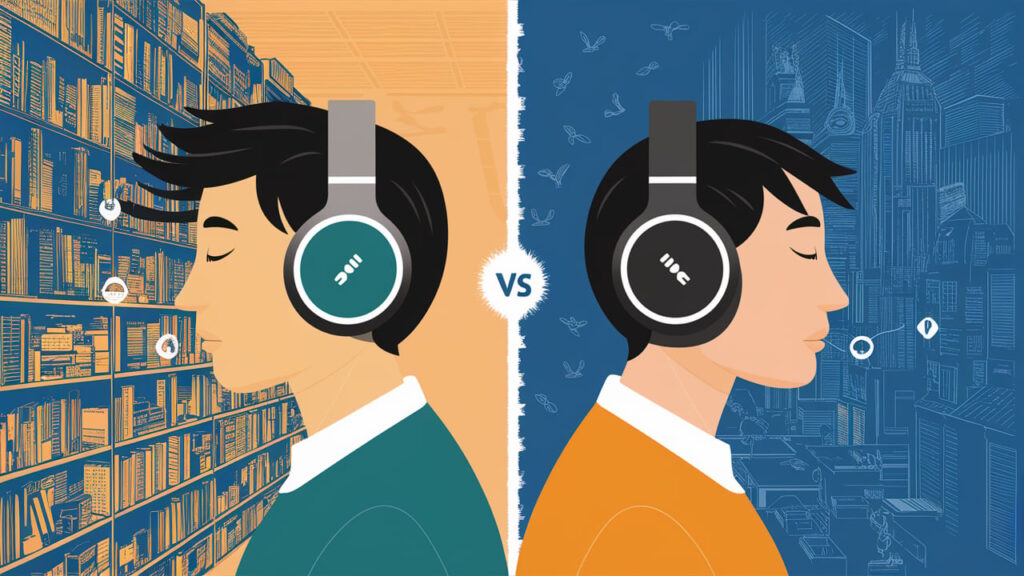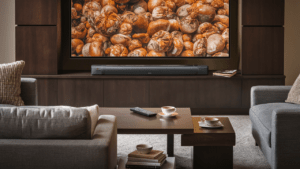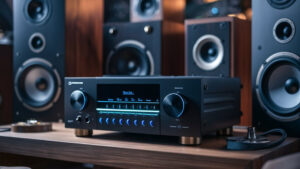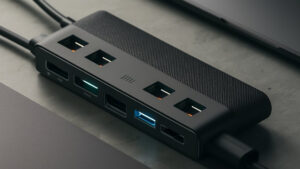Noise isolation and active noise cancellation are two popular features in earbuds. Both technologies aim to reduce unwanted sounds, but they work differently.
Recommended Best Wireless Earbuds 2025
| Recommendation | Product |
| Best Overall | Beats Studio Buds |
| Popular Choice | JBL Pro TWS 2 Noise Cancelling Ear Buds |
| Best Value | TOZO Golden X1 Wireless Earbuds |
| Best Budget | Raycon Fitness Wireless Earbuds |
| Another Excellent Pick | Sennheiser ACCENTUM Wireless Earbuds |
Choosing between noise isolation and active noise cancellation can be tricky. Each type offers unique benefits depending on the environment. Whether you are in a bustling city, a quiet office, or on a noisy flight, the right earbuds can improve your listening experience.
Understanding how these technologies work helps you make an informed decision. This guide explores the differences between noise isolation and active noise cancellation, and how each performs in various settings. Get ready to dive into the world of earbuds and discover which option suits your needs best.
Introduction To Noise Control
In today’s busy world, noise control is vital for a peaceful experience. Earbuds help manage unwanted sounds through different technologies. Understanding how these technologies work can enhance your listening experience.
Importance Of Noise Control
Noise control protects your hearing from loud sounds. It also improves focus and reduces stress. With effective noise control, you can enjoy music or calls without distractions. It is crucial in noisy environments like busy streets or crowded cafes.
Types Of Noise-canceling Technologies
There are two main types of noise-canceling technologies: Noise Isolation and Active Noise Cancellation. Noise isolation blocks external sounds by creating a physical barrier. This is often achieved through snug-fitting ear tips.
Active Noise Cancellation (ANC) uses advanced electronics. ANC detects external noise and creates anti-noise signals to cancel it out. This technology is more effective in reducing constant, low-frequency sounds like airplane engines.
What Is Noise Isolation?
What is Noise Isolation?
Imagine you’re on a crowded bus and you want to escape into your favorite podcast. Noise isolation is your best friend here. Noise isolation works by physically blocking external sounds using the earbud’s design. It’s like closing a door to shut out unwanted noise.
Passive Noise Control
Have you ever put on a pair of earbuds and noticed that the surrounding noise just seems to disappear? That’s passive noise control at work. Passive noise control relies on the earbud’s physical build to block out ambient sounds. It’s all about creating a tight seal in your ear canal.
Quality passive noise control can significantly improve your listening experience. If you get a good fit, you’ll notice how effectively it minimizes outside noise. Your earbuds act like earplugs, making your music or podcast sound clearer.
Materials And Design
The materials and design of your earbuds play a crucial role in noise isolation. Manufacturers use various materials to create a snug fit. Silicone and foam ear tips are popular choices. They mold to your ear shape, enhancing the seal and blocking out more noise.
Design also matters. Over-ear and in-ear designs are effective at providing noise isolation. Over-ear headphones cover your entire ear, while in-ear earbuds fit snugly into your ear canal. Both designs are great for reducing external sounds, but in-ear options are often more portable.
Think about your daily environment. If you’re often in noisy places, high-quality materials and thoughtful design can make a big difference. Wouldn’t it be nice to enjoy your media without distraction?
In summary, noise isolation focuses on physically blocking external sounds. It relies on the earbud’s design and materials to create a barrier against noise. Consider how important this feature is for your listening needs.
Understanding Active Noise Cancellation
Active Noise Cancellation (ANC) technology is a remarkable advancement in audio engineering. It allows users to enjoy music or calls without ambient noise. This is especially useful in noisy environments like airplanes or busy streets. Understanding how ANC works can help you choose the right earbuds for your needs.
How Anc Works
ANC uses microphones to pick up external sounds. These sounds are then processed and inverted by the earbuds. The inverted sound waves cancel out the external noise. This creates a quiet listening experience. ANC is different from passive noise isolation. Passive noise isolation blocks noise using physical barriers, like earbud tips.
Components Of Anc
Several components work together to make ANC effective. First, there are microphones. These are usually placed on the outside and inside of the earbuds. They capture external and internal sounds. Second, there is a digital signal processor (DSP). The DSP analyzes the captured sounds and creates an inverted sound wave. Finally, there are the speakers. They play the inverted sound wave to cancel out the noise.
Noise Isolation Vs Active Noise Cancellation
Understanding the difference between noise isolation and active noise cancellation is essential for choosing the right earbuds. Both technologies aim to provide a better listening experience, but they work in distinct ways. Let’s explore how each one functions and their specific advantages.
Key Differences
Noise isolation relies on physical barriers to block external sounds. Earbuds with good noise isolation have snug-fitting ear tips. These tips create a seal in the ear canal, preventing outside noise from entering.
Active noise cancellation (ANC) uses electronics to reduce ambient sounds. Earbuds with ANC have built-in microphones. These microphones detect external noise and generate opposing sound waves to cancel it out.
Pros And Cons
Noise isolation is simple and doesn’t need batteries. It usually offers better passive sound quality. However, it may not block all types of noise, especially low-frequency sounds.
Active noise cancellation excels in noisy environments. It is effective against constant sounds like engines or air conditioning. But, ANC earbuds often require more power. They might also affect sound quality slightly.
Performance In Different Environments
Understanding how earbuds perform in different environments is crucial. Noise isolation and active noise cancellation (ANC) offer distinct experiences. Let’s explore how each technology fares in various settings.
Quiet Spaces
In quiet spaces, both noise isolation and ANC work well. Noise isolation relies on physical barriers to block external sounds. This passive method is effective where ambient noise is minimal. The snug fit of the earbuds ensures that outside sounds stay out.
On the other hand, ANC uses microphones to detect ambient noise. It then produces opposing sound waves to cancel the noise. In quiet environments, ANC may not show its full potential. But it still provides a serene listening experience.
Noisy Environments
Noisy environments present a challenge for both technologies. Noise isolation can only block a limited range of sounds. It works best for high-frequency noises. For example, chatter in a busy café or office. The physical design of the earbuds helps to some extent.
ANC shines in loud settings. It excels at reducing low-frequency noises. Think of engine sounds on a plane or the hum of a train. ANC adapts to the changing noise levels. This dynamic adjustment offers a more immersive experience.
In summary, noise isolation and ANC have their strengths. Knowing how they perform in different environments helps you choose the right earbuds.

Impact On Sound Quality
Earbuds with noise isolation block external sounds physically, enhancing the listening experience in quiet environments. Active noise cancellation earbuds use technology to cancel out background noise, making them ideal for noisy settings. Both methods improve sound quality based on different surroundings.
### Impact on Sound Quality
When deciding between noise isolation and active noise cancellation (ANC), sound quality is a critical factor. Both technologies handle background noise differently, impacting your listening experience in unique ways. Let’s break it down.
### Audio Clarity
Noise isolation creates a seal in your ears, blocking out external noise. This can enhance audio clarity by reducing distractions. However, it depends heavily on the earbud fit. A poor fit can let noise in, affecting clarity.
ANC uses microphones to analyze and cancel out noise. This technology can offer consistently clear audio, even in noisy environments like airplanes or busy streets. Yet, some users find that ANC can sometimes introduce a slight hiss or affect the natural sound quality.
### Bass Response
A good bass response is essential for a full, immersive sound. Noise isolation earbuds often excel here. The tight seal they create can enhance bass, making it deeper and more resonant. This is particularly noticeable in genres like hip-hop or electronic music.
ANC can also boost bass response but in a different way. By canceling out low-frequency noise, ANC allows bass notes to come through more clearly. However, some users feel that ANC can sometimes make the bass feel less punchy and more subdued.
### Conclusion
Choosing between noise isolation and ANC depends on your needs. If you prioritize audio clarity and a strong bass response, noise isolation might be the way to go. But if you need consistent sound quality in varying environments, ANC offers a compelling alternative.
What do you think suits your lifestyle better? Share your thoughts in the comments!
Battery Life And Power Consumption
When choosing earbuds, one crucial factor to consider is battery life and power consumption. Noise isolation and active noise cancellation (ANC) handle external sounds differently, and this impacts their energy usage. Let’s dive into how these technologies affect your earbud’s battery life.
Anc Power Needs
Active noise cancellation requires more power. The technology involves microphones and processors that create anti-noise signals. This constant processing drains the battery faster compared to passive noise isolation.
Imagine you’re on a long flight. Your ANC earbuds might need a recharge sooner than you’d like. This is because the ANC feature is actively working to cancel out the engine noise.
Have you ever found your ANC earbuds dead halfway through your commute? It’s a common issue due to the higher power requirements of ANC technology.
Battery Life Comparison
Noise-isolating earbuds generally offer longer battery life. They rely on physical barriers to block out noise, consuming less power. This makes them a better choice for extended use.
For instance, if you’re going on a hiking trip, noise-isolating earbuds can last through the entire adventure. You won’t have to worry about finding a charging spot in the wild.
Do you often forget to charge your earbuds? Opt for noise-isolating ones to avoid battery anxiety. You’ll get more playtime without the need for frequent recharges.
Here’s a quick comparison:
| Feature | Noise Isolation | Active Noise Cancellation (ANC) |
|---|---|---|
| Power Consumption | Low | High |
| Battery Life | Longer | Shorter |
| Ideal Use | Extended Listening | Noise-Canceling Environments |
What’s more important to you: longer battery life or superior noise cancellation? Your answer will guide you to the right choice.
Choosing The Right Earbuds
Choosing the right earbuds is critical for your listening experience, especially when considering noise isolation and active noise cancellation (ANC). The technology you choose impacts how well you can enjoy your music or focus on a call, depending on your environment. Let’s break down how to pick the best option for your needs.
User Preferences
First, think about your personal preferences. Do you value complete silence or just want to reduce background noise? If you like to hear some ambient sounds, noise isolation might be better for you. It uses physical barriers to block out noise.
On the other hand, if you crave silence, consider earbuds with ANC. This technology uses microphones to cancel out noise electronically. It’s ideal for loud environments.
Do you find earbuds uncomfortable after a while? Noise-isolating earbuds often have snugger fits, which might be uncomfortable for long periods. ANC earbuds can be more comfortable for extended use.
Use Case Scenarios
Consider where you’ll use your earbuds most often. Are you a frequent traveler? ANC earbuds can be lifesavers on airplanes, trains, or buses. They cut out engine noise effectively.
If you work in a noisy office, ANC can help you focus better. It removes the hum of conversations and office equipment.
For outdoor activities like running or walking, noise isolation might be safer. You’ll still hear important sounds like traffic or people around you.
Think about your daily routine. Do you often switch between quiet and noisy environments? Some earbuds offer hybrid models that combine both technologies. They let you choose the best setting for each situation.
What’s your budget? ANC earbuds are usually more expensive due to their advanced technology. Noise isolation can be a cost-effective option if you’re looking to save money.
Ultimately, the choice between noise isolation and ANC earbuds depends on your lifestyle and preferences. Evaluate your needs carefully to make the best decision.
Future Trends In Earbud Technology
Future trends in earbud technology are evolving rapidly. Earbuds are becoming more advanced, offering better noise control. Both noise isolation and active noise cancellation methods are seeing significant improvements. These innovations are aimed at enhancing user experience in varied environments.
Innovations In Noise Control
Noise control technology is advancing quickly. New materials and designs are used to improve passive noise isolation. These materials block out external sounds more effectively. Active noise cancellation is also improving. Advanced algorithms are reducing unwanted noise better than ever before. Hybrid models combining both methods are becoming popular. They offer superior noise management.
Adaptive noise cancellation is another innovation. It adjusts based on the surrounding environment. This feature offers a personalized experience. Users can enjoy music or calls without interruptions. These advancements make earbuds more versatile. They can handle different noise levels in various environments.
Upcoming Features
Upcoming features in earbud technology are promising. Voice control integration is becoming more common. This allows users to manage their earbuds hands-free. Enhanced battery life is another feature. Longer usage times without frequent charging are expected.
Fitness tracking is also a new addition. Earbuds will monitor heart rate and other metrics. This is useful for health-conscious users. Improved connectivity is another feature. Faster and more stable Bluetooth connections are being developed. This ensures a seamless listening experience.
Future earbuds will have smarter noise control. They will learn from user habits and preferences. This makes them more efficient in noise management. These features show that earbud technology is advancing. Users can expect better performance and convenience.
Frequently Asked Questions
Is Active Noise Cancellation Better Than Environmental Noise Cancellation?
Active noise cancellation (ANC) is generally better than environmental noise cancellation (ENC). ANC offers superior noise reduction by actively countering sound waves. This results in a quieter listening experience.
Do Noise Cancelling Headphones Work In Loud Environments?
Yes, noise cancelling headphones work well in loud environments. They reduce background noise effectively, enhancing your listening experience.
What Is Environmental Noise Cancellation In Earbuds?
Environmental noise cancellation in earbuds reduces background noise. This technology enhances sound quality during calls and music playback. It uses microphones to detect and neutralize external sounds. Enjoy a clearer audio experience in noisy environments.
What Do Noise Isolating Earbuds Do?
Noise isolating earbuds block external sounds, allowing you to enjoy music or calls without distractions. They enhance audio clarity.
Conclusion
Choosing between noise isolation and active noise cancellation depends on your needs. Noise isolation works well in quieter settings. Active noise cancellation is great for noisy environments. Think about where you’ll use your earbuds most. Both options have their own benefits.
Consider your environment and preferences. Make an informed choice for the best listening experience. Enjoy your music with fewer distractions.








